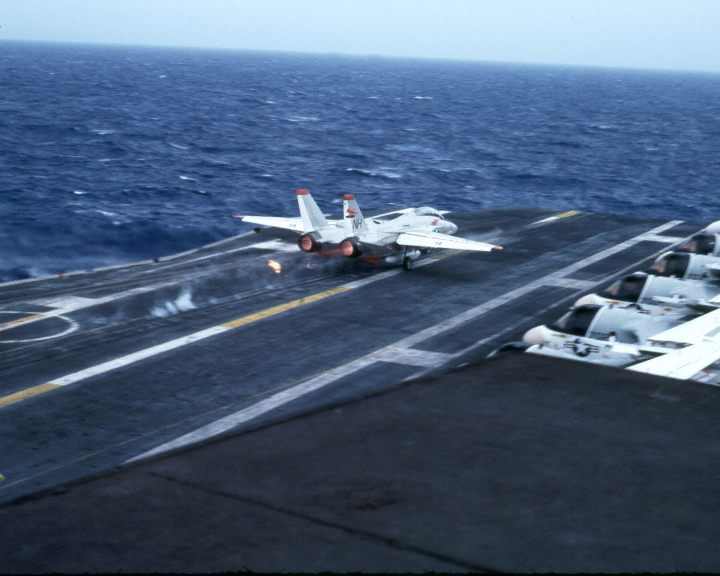
 |
|
|

Photo by C. Jeff Dyrek
When this F-14 Tomcat took off, there was a large bang and a fireball backfires out of the exhaust.
Jeff, Working on Military Fighter Aircraft for 24 years, I have seen this many times. This is undoubtedly a fire ball coming from the accumulation of fuel in the fuel vent system. One of the answers on your website is 100% accurate. Other type of Fighter Aircraft do the exact same thing. It is harmless and some aircraft have been modified to prevent this occurrence, however the modification is not 100% successful. Chief Smith, Active Duty, USAF
Mark Platt
:
From Animal112:
From Supulveda:
AO2 James Floyd
A CURRENT F-14 GUY 6-24-99The explanation of a corrosive/salt buildup is a definite possibility, along with (more likely) an afterburner blow-out. This only means the AB blew out momentarily, and then relit-- the buildup of fuel in the spraybars / nozzle during the moment the AB was not lit caused the 'puff.' While certainly not common, this is not unheard of. The AB usually relights itself, or is relit by the pilot cycling the throttle (s) out of AB and back again.ex-AMS2 "Country"
Steven
Hesley
army.mil
If you'll notice the fireball is definitely below the horizontal axis of the port engine. This would seem to rule out any kind of a backfire. Engines don't throw curve balls. I would conclude that the cat steam ignition theory is the correct explanation in this case. Notice how the flame appears closer to the deck than the engine, and appears to follow the convection of the escaping steam and engine exhaust.
S.F.Hesley
CPOMEA RN Wayne
Clancy
From a gas turbine point of view, if the aircraft successfully took off and flew its op then I'd go for an AB related problem. If the plane crashed in a fiery heap, I'd go for a catastrophic component failure (FOD damage?), compressor surge or stall serious enough to affect combustion during the rather sensitive manooeuvre of take off is doubtful in a well designed modern engine and intake system. ex CPOMEA RN Wayne Clancy As you can see,
there is a little conflict of information here.
To tell you the truth,
the more technical the explanation, the more I believe it.
If anyone
has any more information,
|
<<<
Previous Photo
Next Photo >>>
Look at these other USS
Kitty Hawk Exhibits.
Home
Many
More Exhibits
Dan
Collier
Darren
Drake
Jeff
Dyrek 77-78
Howard
Freeman
Brad
Jones
Morgan
34th
Fighter Squadron
413th Fighter Group
Famous People
Model
Ships
Art
Books
Model
Airplanes
Videos
Video
Games
|
|
To See All
Exhibits in the Yellow Airplane Museum, Click Here.
Yellow
Airplane Home Base
Airplane
Books
*
Airplane
Movies
*
*
Airplane
Models
*
Camaros for SaleAircraft
Calendars
*
Jet
Fighter Models
*
Flight
Manuals
Exhibits
* Museums
*
RC
Boats
*
Ship
Models
*
Sailing
Ships
Tanks
*
Military
Vehicles
*
*
*
Action
Figures
*
Train
Sets
*
Railroad
Books
*
Real Sports Cars for Sale
*
;
Real Sports Cars for
Sale
*
Adventures
*
Survival Equipment
More Aviation Art
*
More Models
*
Click Here to go to the YellowAirplane Online Museum
Look at these exhibits and tell me what these men really fought for.
the 34th fighter Squadron
USS Kitty Hawk
| . |